Canadian Warplanes 6: Canadair F-86 Sabre
Canadair F-86 Sabre
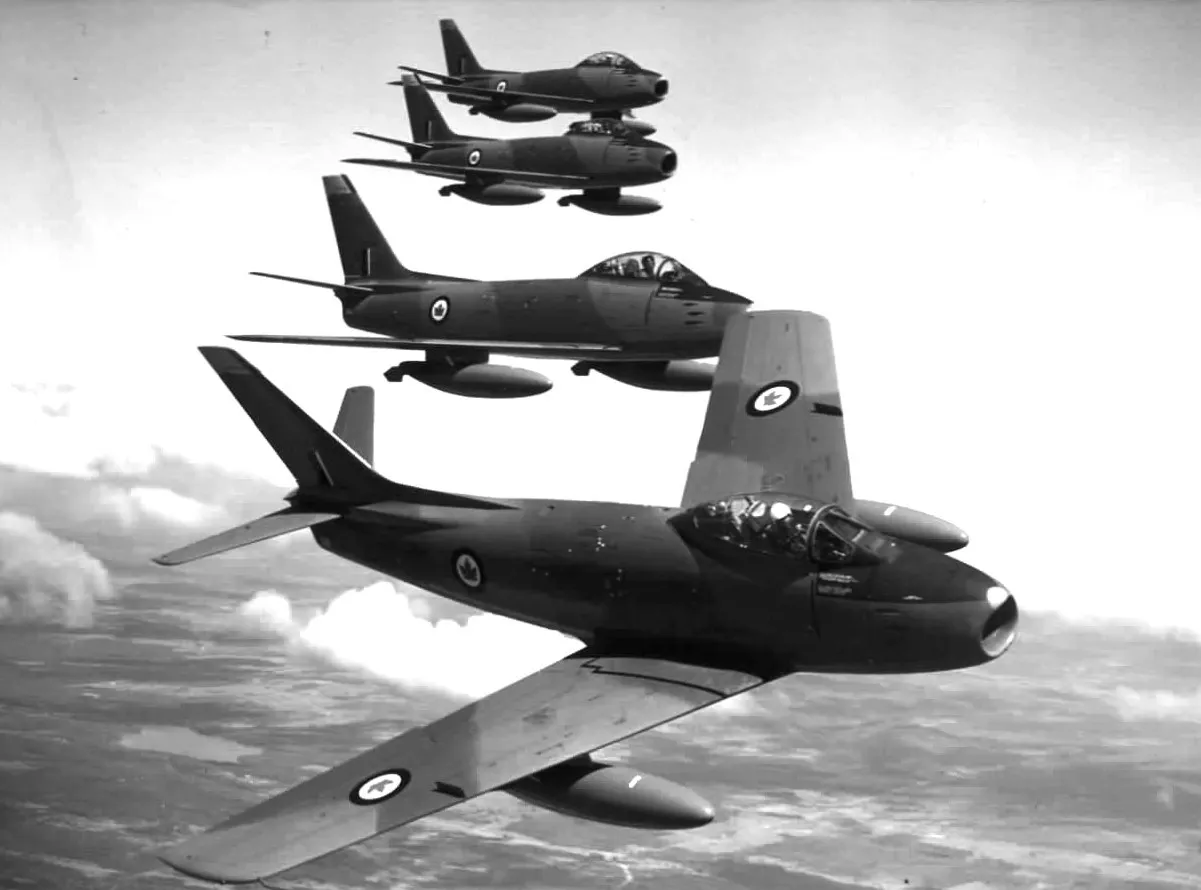
(RCAF Photo courtesy of the Canadian Aviation Preservation Association)
Canadair F-86 Sabre Mk. 5 formation, over Europe.
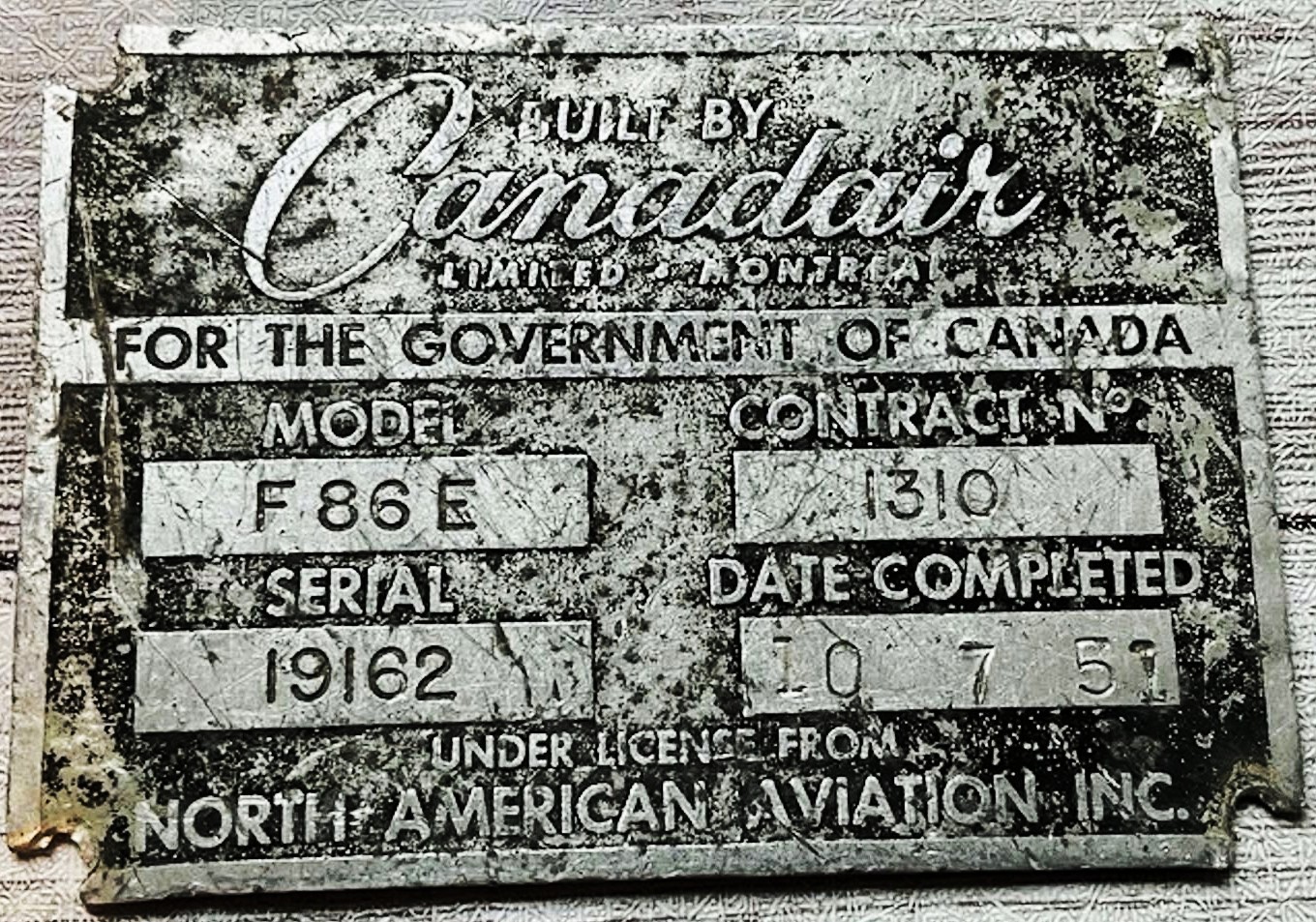
(James Craik Photo)
The Canadair Sabre jet fighter was built by Canadair under licence from North American Aviation. It was a variant of the North American F-86 Sabre and was produced until 1958. It was primarily used by the RCAF it was until replaced with the Canadair CF-104 Starfighter in 1962. Several other air forces also operated Canadian-built Sabres. (Wikipedia)
The North American F-86 Sabre, sometimes called the Sabrejet, is a transonic jet fighter aircraft. Produced by North American Aviation, the Sabre is best known as the United States' first swept-wing fighter that could counter the swept-wing Soviet MiG-15 in high-speed dogfights in the skies of the Korean War (1950–1953), fighting some of the earliest jet-to-jet battles in history. Considered one of the best and most important fighter aircraft in that war, the F-86 is also rated highly in comparison with fighters of other eras. Although it was developed in the late 1940s and was outdated by the end of the 1950s, the Sabre proved versatile and adaptable and continued as a front-line fighter in numerous air forces.
Its success led to an extended production run of more than 7,800 aircraft between 1949 and 1956, in the United States, Japan, and Italy. In addition, 738 carrier-modified versions were purchased by the US Navy as FJ-2s and -3s. Variants were built in Canada and Australia. The Canadair Sabre added another 1,815 aircraft and the significantly redesigned CAC Sabre (sometimes known as the Avon Sabre or CAC CA-27), had a production run of 112. The Sabre is by far the most-produced Western jet fighter, with a total production of all variants at 9,860 units.
The fighter-bomber version (F-86H) could carry up to 2,000 lb (907 kg) of bombs, including an external fuel-type tank that could carry napalm. Unguided 2.75-inch (70-millimeter) rockets were used on some fighters on training missions, but 5-inch (127 mm) rockets were later carried on combat operations. The F-86 could also be fitted with a pair of external jettisonable jet fuel tanks (four on the F-86F beginning in 1953) that extended the range of the aircraft. Both the interceptor and fighter-bomber versions carried six 0.50 in (12.7 mm) M3 Browning machine guns with electrically-boosted feed in the nose (later versions of the F-86H carried four 20 mm (0.79 in) cannon instead of machine guns). Firing at a rate of 1,200 rounds per minute, the 0.50-inch guns were harmonized to converge at 1,000 ft (300 m) in front of the aircraft, using armor-piercing (AP) and armor-piercing incendiary (API) rounds, with one armor-piercing incendiary tracer (APIT) for every five AP or API rounds. The API rounds used during the Korean War contained magnesium, which were designed to ignite upon impact, but burned poorly above 35,000 ft (11,000 m) as oxygen levels were insufficient to sustain combustion at that height. Initial planes were fitted with the Mark 18 manual-ranging computing gun sight. The last 24 F-86A-5-Nas and F-86Es were equipped with the A-1CM gunsight-AN/APG-30 radar, which used radar to automatically compute a target's range, which later proved to be advantageous against MiG opponents over Korea. (Wikipedia)
CanadairF-86 Sabre Mk. 1 (1), (Serial No. 19101), Canadair F-86 Sabre Mk. 2 (350), (Serial Nos. 19102-19199, 19201-19452), Mk. 3 (1), (Serial No. 19200), Mk. 4 (71), (Serial Nos. 19453-19463, 19491, 19575, 19579, 19582, 19584, 19585, 19590, 19597-19599, 19601, 19606, 19615-19617, 19619, 19624, 19627-19629, 19631, 19632, 19635-19637, 19639, 19642, 19643, 19647, 19649, 19650, 19652, 19653, 19655, 19657, 19659-19661, 19663-19665, 19667-19671, 19673-19675, 19677, 19679, 19680, 19682, 19684-19686, 19689, 19691, 19695, 19702), Mk. 5 (370), (Serial Nos. 23001-23370), F-86B Mk. 6 (390), (Serial Nos. 23371-23760), plus one North American F-86A (Serial No. 49-1069), for a total of 1,184 of all Canadian Marks of the Sabre.
RCAF On Strength (1191), RCAF 400 Squadron (64), Canadian Aircraft Losses (104), Canadian Manufactured (1554). Detailed records of all known RCAF and Canadian-built aircraft may be viewed on line in the Canadian Aircraft Serials Personnel Information Resource (CASPIR). The CASPIR website is researched, coded, and maintained entirely by Canadian Warplane Heritage Museum (CWHM) volunteers with only one staff assisting periodically. This work has taken several years and is unlikely to be finished as continuing research leads to “new finds” and rediscovered Canadian aviation heritage and history. The CWHM volunteer team looks forward to continuing to update and correct the record as additional information and photos are received. Check here for the Sabre.
All RCAF Canadair F-86 Sabre Squadrons are listed on a separate page on this website.

(DND Photo via James Craik)
Canadair F-86 Sabre Mk. 1 (Serial No. 19101), coded CK-R, National Aeronautical Establishment (NAE), Experimental Proving Establishment (EPE), ca 1951. This Sabre was assembled from F-86A components supplied by North American. First flight on 9 Aug 1950, after being towed on public streets from Cartierville factory to Dorval airport, Quebec. Flown to Malton, Ontario on 18 Aug 1950, towed to Canadian National Exhibition grounds in Toronto for display. Coded CK-R for early tests. Later operated by Central Experimental and Proving Establishment at RCAF Station Uplands, Ontario, coded PX-101. It was on display on pedestal in front of 700 Wing of the RCAF Association in Edmonton, Alberta from 14 July 1965 to 2009, but is now preserved indoors in the Alberta Aviation Museum, Edmonton, Alberta.

(Library and Archives Canada Photo, MIKAN No. 3584475)
Canadair F-86 Sabre Mk. 1 (Serial No. 19101), coded CK-R, National Aeronautical Establishment (NAE), Experimental Proving Establishment (EPE), 30 Jan 1951.

(DND Photo via James Craik)
Canadair F-86 Sabre Mk. 1 (Serial No. 19101), coded CK-R, National Aeronautical Establishment (NAE), Experimental Proving Establishment (EPE), 20 Mar 1951. The original Canadair F-86 Sabre Mk. 1 (Serial No. 19101), first flew at Montreal’s Dorval airport on 9 Aug 1950. This aircraft was primarily built using American-made parts similar to F-86A Sabre.

(Author Photo)
Edmonton, Alberta, Alberta Aviation Museum, Canadair F-86 Sabre Mk. 1 (Serial No. 19101), PX-101. Indoors.
After the first prototype, designated F-86 Sabre Mk. 1, Canadair immediately began production in earnest with an improved Mk. 2 model. The Mk. 2 was essentially an F-86E with an “all flying” tailplane to provide better flying characteristics as well as a flat windscreen. The Mk. 2 was also powered by a General Electric J-47-GE-13 engine. The Canadair Sabre was the RCAF’s most numerous post-war fighter. The Sabre was flown with the RCAF’s No. 1 Canadian Air Division in Europe (at one time there were 12 Squadrons of them able to take to the air at the same time). The aircraft was the last Canadian fighter to use guns (six .50 calibre machine guns mounted in the nose) as its primary weapon. During the Korean War, Canada supplied the USAF with 60 F-86 Sabre Mk. 2 (USAF F-86E-6).
One Mk. 2 is preserved at Canadian Forces Base Valcartier, Québec, Canadair F-86 Sabre Mk. 2 (Serial No. 19118), painted as 19318. It previously was painted as 19430 while on display at CMR, St. Jean, Québec.
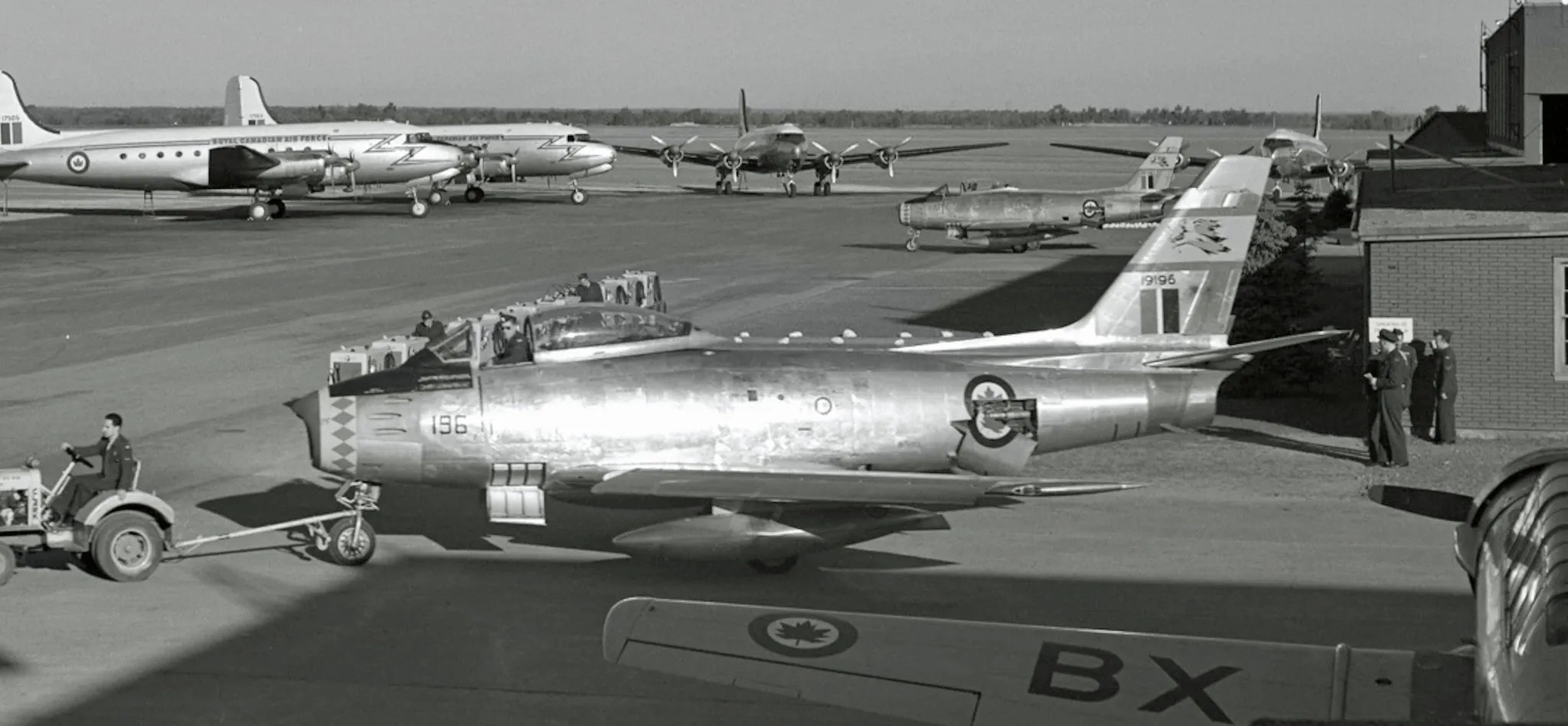
(DND Photo)
Canadair F-86 Sabre Mk. 2 (Serial No. 19196), No. 439 Squadron, Canadair CL-2 North Stars, and a CCF Harvard, at RCAF Station Uplands, Ontario, in 1952.
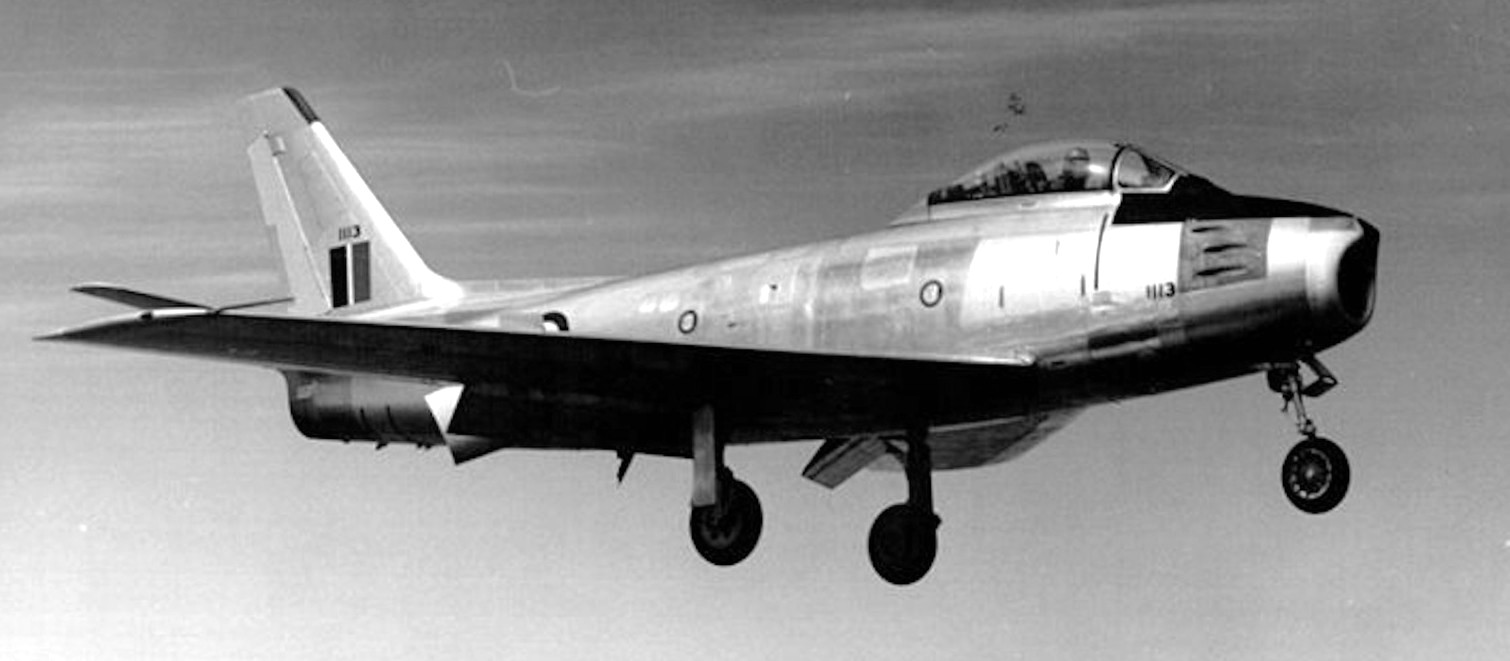
(DND Photo viaJames Craik)
Canadair F-86 Sabre Mk. 2 (Serial No. 19113).
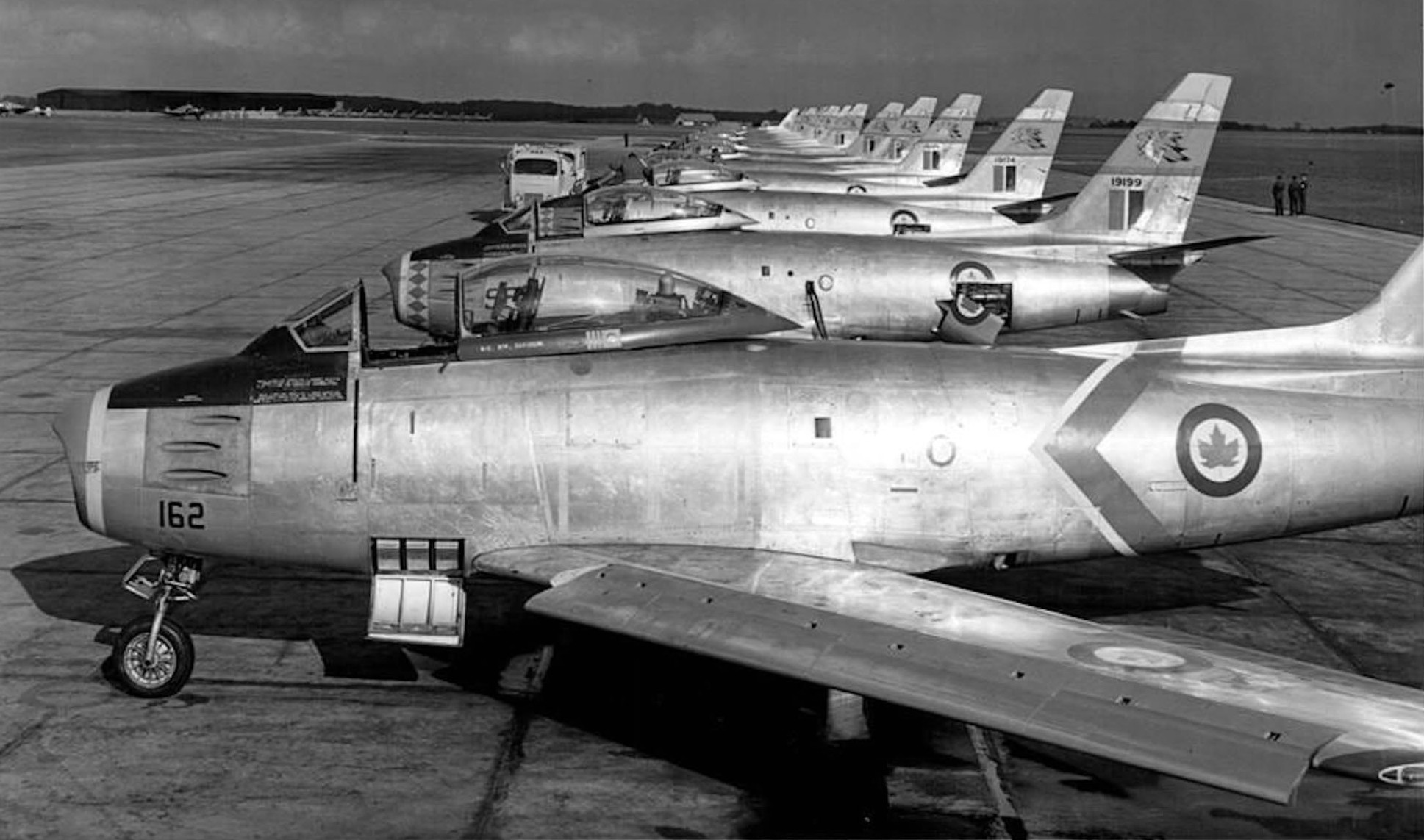
(DND Photo viaJames Craik)
Canadair F-86 Sabre Mk. 2, No. 162, No. 439 Squadron, (Serial No. 19199) visble behind it.
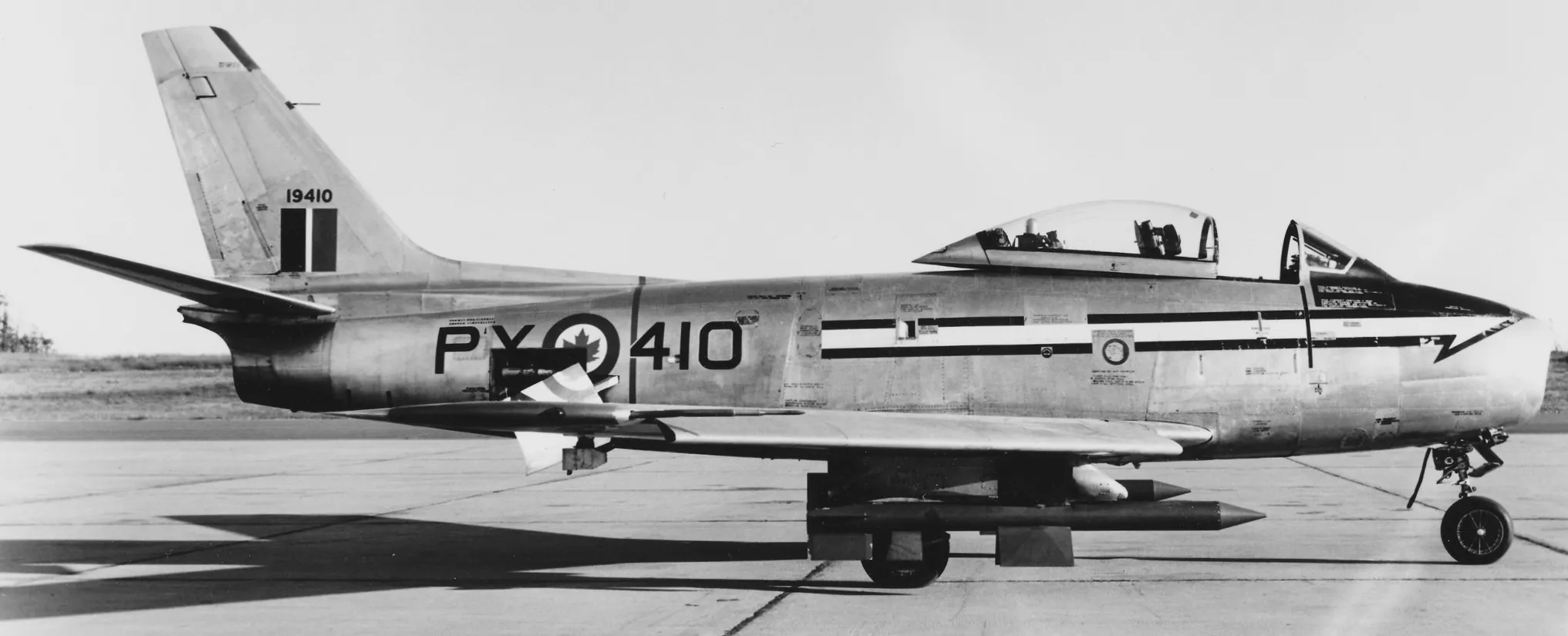
(DND Photo via James Craik)
Canadair F-86 Sabre Mk. 2 (Serial No. 19410), coded PX, with the Canadian Armament Research and Development Establishment (CEPE). CEPE developed the Velvet Glove air-to-air missile. This research took place at what was then known as RCAF Station Cold Lake, now known as CFB Cold Lake, Alberta.

(DND Photo)
Canadair F-86 Sabre Mk. 2, No. 410 Squadron and No. 441 Squadron, on board HMCS Magnificent, Norfolk Virginia, Oct 1951.


(Philippe Colin Photos)
Canadair F-86 Sabre Mk. 2 (Serial No. 19118), painted as (Serial No. 19430), No. 430 Squadron, CFB Valcartier, Québec.


(Eric Desbiens Photos)
Canadair F-86 Sabre Mk. 2 (Serial No. 19118), painted as (Serial No. 19430), No. 430 Squadron, CFB Valcartier, Québec.

(Canadair Photo via Tony Edmundson)
Canadair F-86 Sabre Mk. 3 (Serial No. 19200), initial engine runs at Canadair; note the original slatted short chord wing. With its first flight on 25 Sep 1952, it used by Canadair for trials before being passed to the RCAF. It was nearly lost in high speed dive by Canadair pilot W. Longhurst during early tests, when a spanner left in the cockpit jammed the elevator controls during manufacturers trials. Pilot bent spanner during recovery. To Edwards AFB in California for calibrations and other trials in Apr 1953. Used by Jacqueline Cochran to set 3 world speed records for women in May and June 1953, from Edwards AFB. It carried no markings apart from the serial number on its fin for these flights. She is reported to have become the first woman to fly through the sound barrier during these flights. Later brought up to full Mk. 4 standards, but apparently not redesignated. Reported on display at St. Jean, Quebec, no dates. Preserved, on display at former RCAF Station Downsview, Ontario in the 1980s. Later with the Western Canada Aviation Museum in Winnipeg, Manitoba. By 2000 at the Reynolds Museum in Wetaskawin, Alberta.
The Mk. 3 Sabre was powered by an Avro Orenda 3 engine. In 1952, Jacqueline Cochran, then aged 47, decided to challenge the world speed record for women, then held by Jacqueline Auriol. She tried to borrow an F-86A from the USAF, but was refused. She was introduced to an RCAF Air Vice-Marshal who, with the permission of the Canadian Minister of Defence, arranged for her to borrow 19200, the sole Sabre Mk. 3. Canadair sent a 16-man support team to California for the attempt. On 18 May 1953, Ms. Cochran set a new 100-km speed record of 1050.15 km/h (652.5 mph). Later on 3 June, she set a new 15-km closed circuit record of 1078 km/h (670 mph). While she was in California, she exceeded 1270 km/h in a dive, and thus became the first woman to exceed the speed of sound.[1] This historic Mk. 3 is preserved with the R-AM, Wetaskiwin, Alberta, Canadair F-86 Sabre Mk. 3 (Serial No. 19200). It was previously held by the WCAM in Winnipeg, Manitoba, up to 2000.

(DND Photo via James Craik)
Canadair F-86 Sabre Mk. 3 (Serial No. 19200).

(DND Photo via Mike Kaehler)
Canadair F-86 Sabre Mk. 3 (Serial No. 19200). This was the only Mk. 3, and was the first Canadair built Sabre with an Orenda engine.

(DND Photo via James Craik)
Canadair F-86 Sabre Mk. 4 (Serial No. 19702), coded VH, No. 444 Squadron, A.J. Bauer at the controls.
The next major production model was the Sabre Mk. 4, which originally was to have been powered by an Orenda designed engine but to retain commonality with the F-86E, it also carried the J47-GE-13. Various design improvements were incorporated throughout the aircraft. 438 Mk. 4 Sabres rolled off the assembly lines.

(F/O Rigby John Stamison Photo, from Paul Stamison via James Craik)
Canadair F-86 Sabre Mk. 4 (Serial No. 19636), No. 444 Squadron, coded VH, at RCAF Station St Hubert, Quebec, prior to Leapfrog IV, September 1953.

(DND Photo via James Craik)
Canadair F-86 Sabre Mk. 5 (Serial No. 23360), No. 1150.

(DND Photo via Serge L'Hostie)
Canadair F-86 Sabre Mk. 5 (Serial No. 1111), on a test flight over Montreal.
The Sabre Mk. 5 was the first production model with a Canadian engine utilising the Avro Orenda 10 engine rated at 6,355-lbs thrust. The bigger Orenda engine necessitated a larger diameter opening in fuselage frames and stronger engine mounts. An important structural modification was the introduction of a fixed leading edge to replace the automatic slats on earlier versions. This change was designed to enhance the high altitude performance of the aircraft. Small wing fences were also introduced at the 70% span position. These modifications were successful but also resulted in a corresponding decrease in low speed handling characteristics. 370 Mk. 5 aircraft were built.

(Library and Archives Canada Photo, MIKAN No. 3585140)
Canadair F-86 Sabre Mk. 5 (Serial No. 23014) coded PX, CEPE, Air Force Day, RCAF Station Rockcliffe, Ontario, 11 June 1955.

(Canadair Photo via Bill Cumming)
Canadair F-86 Sabre Mk. 5 (Serial No. 23321), c/n 1111. This Sabre went to the West German Air Force in 1958.
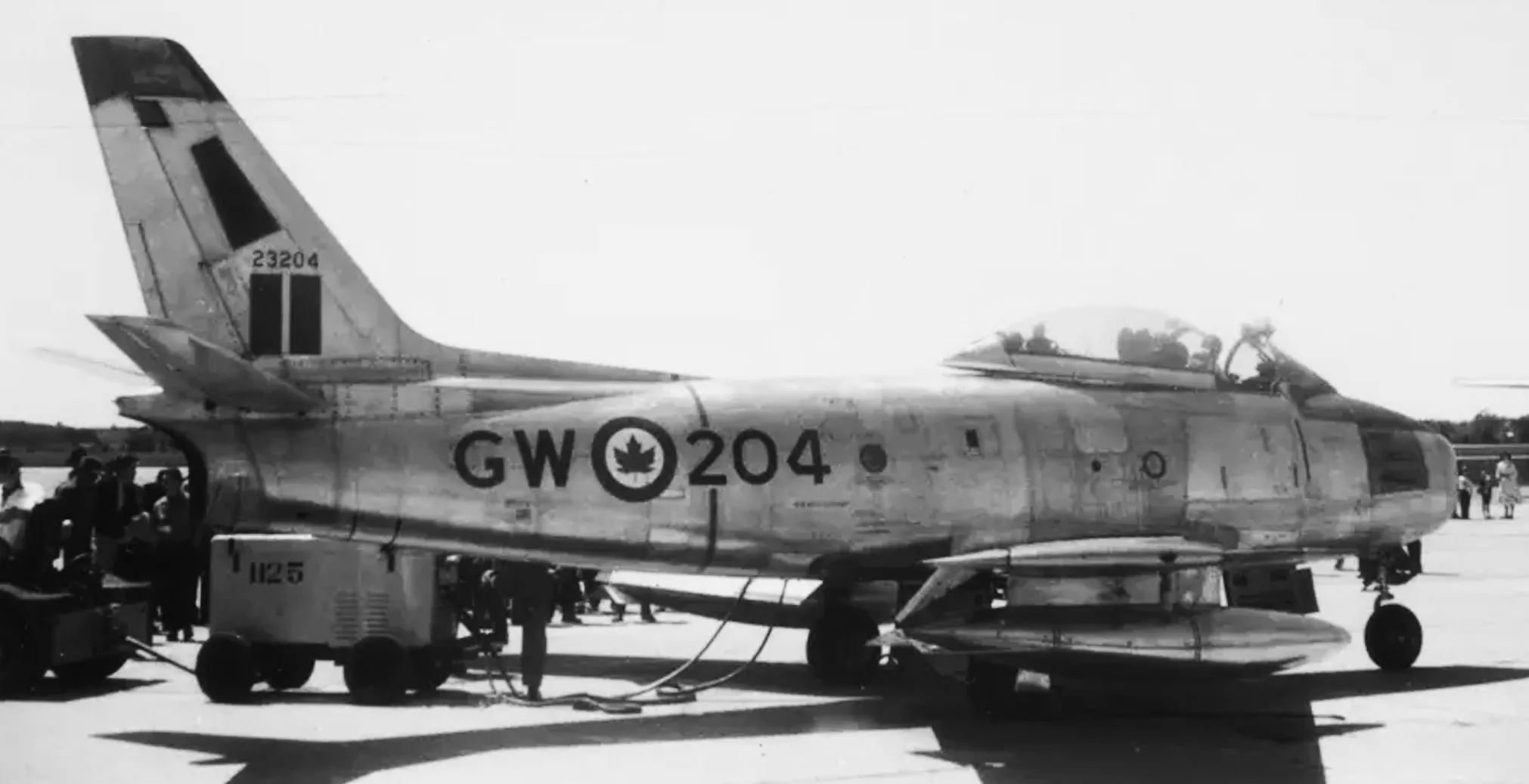
(DND Photo via James Craik)
Canadair F-86 Sabre Mk. 5 (Serial No. 23204), No. 400 Squadron, coded GW.

(RCAF Photo via James Craik)
Canadair F-86 Sabre Mk. 5 formation, over Europe.

(DND Archives Photo PC-2144)
Canadair F-86 Sabre Mk. 6 (Serial No. 23757), one of 390 Sabre Mk. 6 (the last version, with Avro Orenda 14 engines) that served with the RCAF. This Sabre wears the camouflage developed for all RCAF European-based operational aircraft. The photo was taken while the aircraft belonged to No. 1 Overseas Ferry Unit (OFU) based at St. Hubert, Quebec, which was formed in 1953 to ferry Sabres and CT-133s across the North Atlantic.
The Mk. 6 Sabre was powered by the two-stage Avro Orenda 14 engine with a 7,275-lb thrust rating. Max Speed: 606 mph (975 km/h); Cruising Speed: 489 mph (787 km/h); Service Ceiling: 54,000 ft (16,458 m); Range: 1,486 m (2,391 km), Weight Empty: 10.618 lbs (4,818 kg), Gross: 14,613 lbs (6,634 kg). Span: 37 ft 111/2 in (11.57 m) Length: 37 ft 6 in (11.43 m) Height: 14 ft 9 in (4.50 m) Wing Area: 287.9 sq ft (26.74 sq m). Armament: Six .50 calibre machine guns and provisions for tanks, bombs, & rockets (unguided). Cost: $360,000.
The wing leading slats were re-introduced while retaining portions of the Mk. 5 wing configuration. The Mk. 6 therefore acquired superb combat manoeuvring. With this combination of engine and aerodynamics, the Mk. 6 was widely regarded as the best “dog-fighter” of its era. The RCAF’s Golden Hawks team initially flew Mk. 5, but were soon equipped with the excellent Sabre Mk. 6.[2] The Golden Hawks flew in aerobatic display shows throughout the country until their disbandment in February 1964. Canada’s last Sabre was retired in 1970, although Starfighters had begun to replace them in late 1962.[3]

(DND Photo)
Canadair F-86 Sabre formation, over la Citadelle, Quebec City.




(RCAF Photos via Mike Kaehler)
Canadair F-86E Sabre Mk. 5 (Serial No. 23021), designated CL-13E, which was specially modified to the area rule concept. Unfortunately, the marginal performance improvement did not justify such a major modification. Area rule is used to reduce an aircraft's drag at transonic and supersonic speeds. Note the fuselage bulges. After retirement 23021 went to Flight Systems Inc, Mojave, California, Reg. No. N1046D. 23021 crashed at White Sands Missile Range, New Mexico on 1 Feb 1980.

(DND Photo via James Craik)
Canadair F-86 Sabre Mk. 5, RAF (Serial No. XB989), No. 832.

(DND Photo via James Craik)
Canadair F-86 Sabre Mk. 5 (Serial No. 23019), factory fresh.

(RCAF Photo)
Canadair F-86 Sabre Mk. 5 (Serial No. 23273), with Central Flying School, RCAF Station Trenton, Ontario.

(RCAF Photo)
Canadair F-86 Sabre Mk. 5 (Serial No. 23273), No. 1063. This Sabre flew with the Central Flying School at RCAF Station Trenton, Ontario, from 1954-57 and with No. 1 OTU at RCAF Station Chatham, New Brunswick, from 1960 until she was written off in a Category A crash in May 1964.
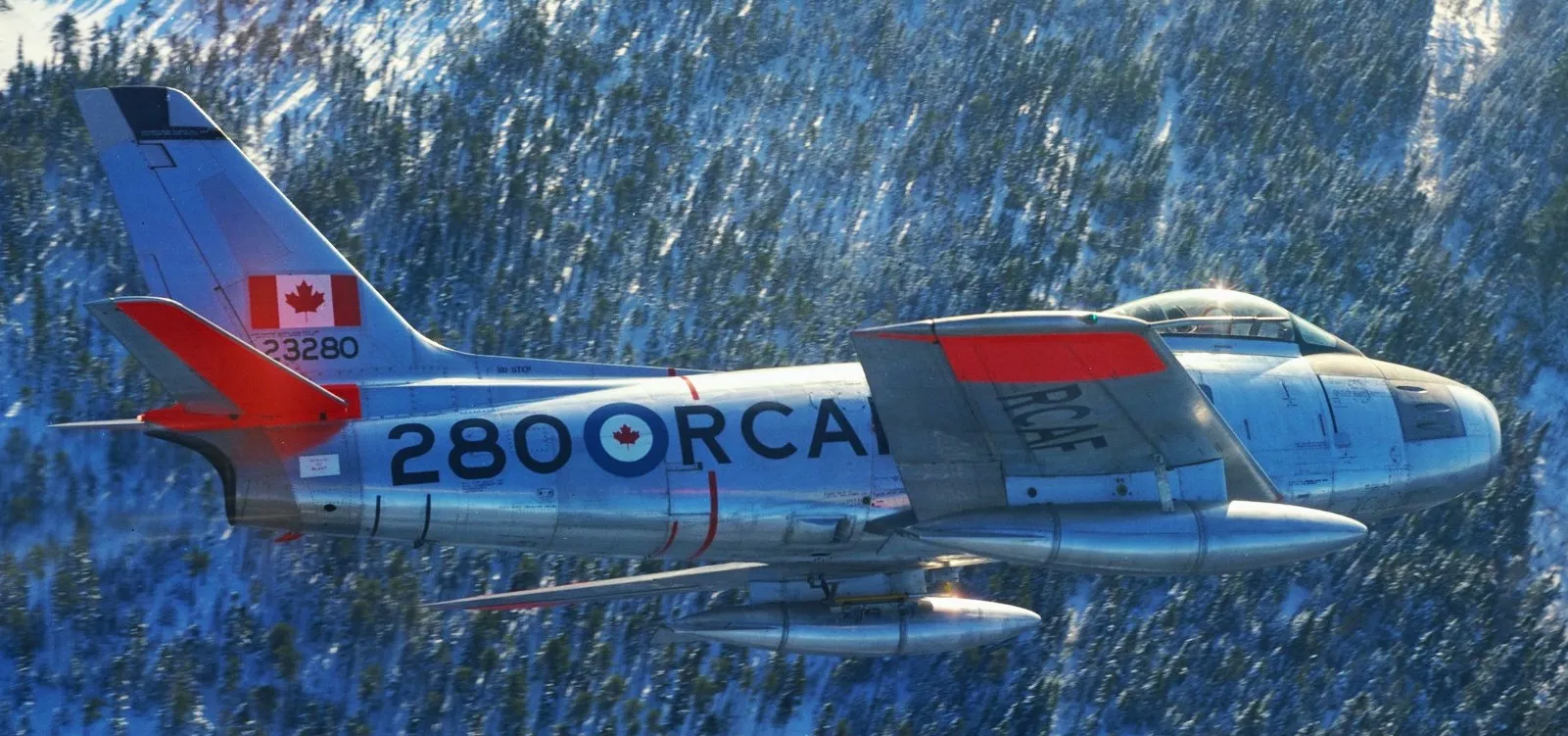
(DND Photo via James Craik)
Canadair F-86 Sabre Mk. 5 (Serial No. 23280), No. 1 (F) Operational Training Unit (OTU), RCAF Station Chatham, New Brunswick.

(DND Photo via James Craik)
Canadair F-86 Sabre Mk. 5 (Serial No. 23283), No. 1 (F) Operational Training Unit (OTU), RCAF Station Chatham, New Brunswick.
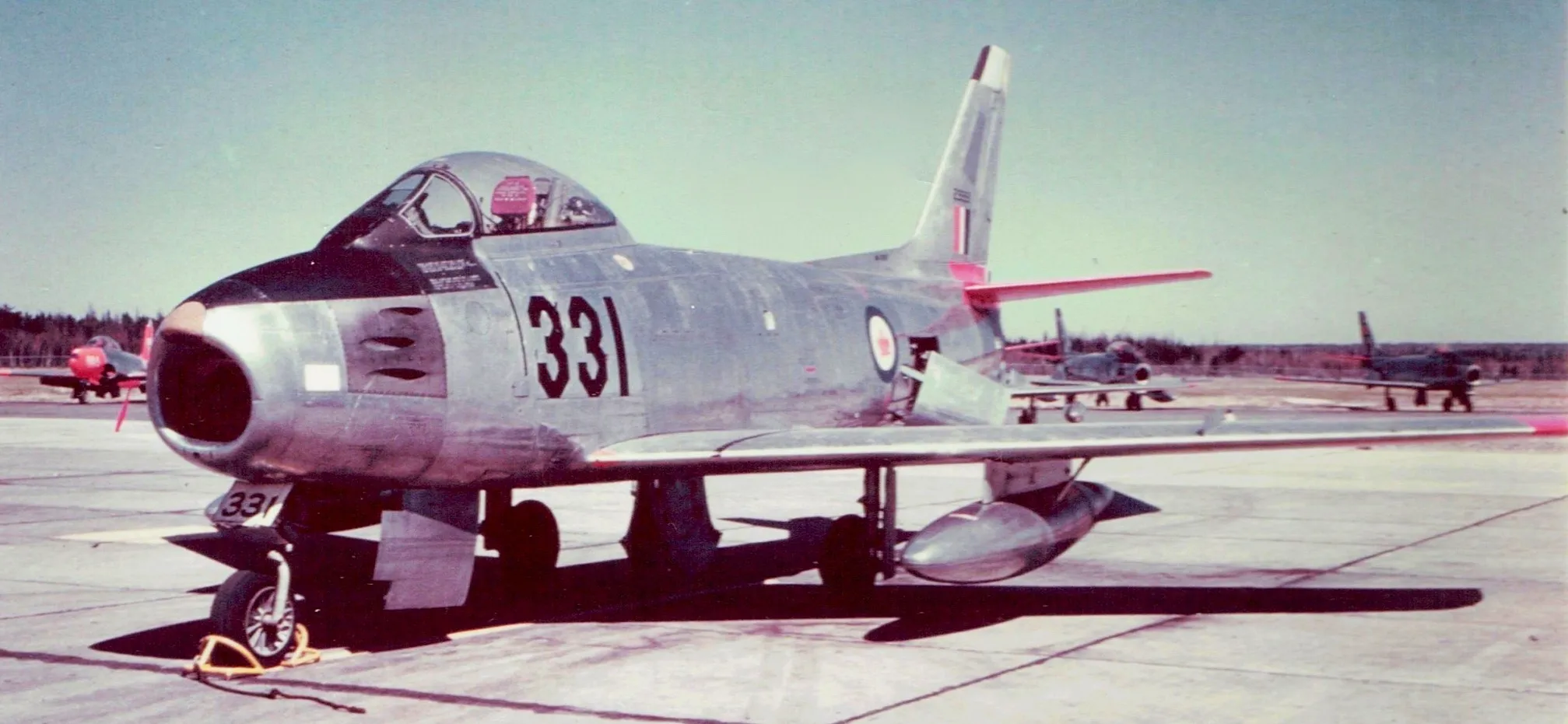
(Mal Joyce Photo via James Craik)
Canadair F-86 Sabre Mk. 5 (Serial No. 23331, No. 1 (F) Operational Training Unit (OTU), RCAF Station Chatham, New Brunswick.

(DND Photo via James Craik)
Canadair F-86 Sabre Mk. 5 (Serial No. 23362) launching from CFB Chatham, New Brunswick armed with 3.75-inch rockets.

(DND Photo via James Craik)
CanadairF-86 Sabre Mk. 5 (Serial No. 23362), No. 1 (F) Operational Training Unit (OTU), RCAF Station Chatham, New Brunswick, firing it's 3.75-inch rockets.

(DND Photo via James Craik)
Canadair F-86 Sabre Mk. 5 (Serial Nos. 23211 and 23362), No. 1 (F) Operational Training Unit (OTU), RCAF Station Chatham, New Brunswick.

(DND Photo via James Craik)
Canadair F-86 Sabre Mk. 5 (Serial No. 23211), No. 1 (F) Operational Training Unit (OTU), RCAF Station Chatham, New Brunswick.

(DND Photo via James Craik)
Canadair F-86 Sabre Mk. 5 (Serial Nos. 23211), No. 1 (F) Operational Training Unit (OTU), RCAF Station Chatham, New Brunswick.

(DND Photo via James Craik)
RCAF Station Chatham, New Brunswick, flight line in the mid-19 50s. At least 47 Canadair F-86 Sabres are on the tarmac and one Canadair North Star.

(DND Photo via James Craik)
Canadair F-86 Sabre Mk. 5s (Serial Nos. 23235, 23338, 23243 and 23241), from Tactical Flight at RCAF Station Chatham, New Brunswick, are seen in a stepped up formation Echelon Port. The four aircraft were participating in the International Air Display, Toronto, Ontario.

(DND Archives Photo, PC-1311)
Canadair F-86 Sabre Mk. 5 (Serial Nos. 23235, 23338, 23243 and 23241), from Tactical Flight at RCAF Station Chatham, New Brunswick, are seen in a stepped up formation Echelon Port. The four aircraft were participating in the International Air Display, Toronto.

(RCAF Photo)
Canadair F-86 Sabre Mk. 5 (Serial No. 23360), formation.

(RCAF Photo)
Canadair F-86 Sabre Mk. 5 formation over RCAF Station Chatham, New Brunswick.

(DND Photo via James Craik)
Canadair F-86 Sabre Mk. 5 (Serial No. 23079), No. 1 (F) Operational Training Unit (OTU), RCAF Station Chatham, New Brunswick, 1968.

(DND Photo via James Craik)
Canadair F-86 Sabre Mk. 5 (Serial No. 23079), No. 1 (F) Operational Training Unit (OTU), RCAF Station Chatham, New Brunswick, 1968.

(Boeing Photo via The Jive Bomber)
Canadair F-86 Sabre Mk. 5 (Serial No. 23096), at Boeing Field for its new life as a chase plane in the flight test division, c1962.

(Boeing Photo via The Jive Bomber)
Canadair F-86 Sabre Mk. 5 (Serial No. 23096), at Boeing Field for its new life as a chase plane in the flight test division, c1962.

(DND Photo via James Craik)
Canadair F-86 Sabre Mk. 5 (Serial No. 23190), CFB Chatham, New Brunswick, 1968.

(DND Photo via James Craik)
Canadair F-86 Sabre Mk. 5 (Serial No. 23196), No. 413 Squadron, coded AP.

(DND Photo)
Canadair F-86 Sabre Mk. 5 (Serial No. 23102), STU (Sabre Transition Unit).

(DND Photo via James Craik)
Canadair F-86 Sabre Mk. 5 (Serial No. 23335), night start, CFB Chatham, New Brunswick.

(RCAF photo via Mike Kaehler)
Canadair F-86 Sabre, being de-armed after an air-to-air gunnery exercise, by two Munitions and Weapons Technicians, LAC Roy Mann, M and W Tech, andn LAC Art Murphy, M and W Tech.

(DND Photo via James Craik)
Canadair F-86 Sabre Mk. 5 formation, over Europe. (Serial No. 23310), No. 430 Squadron, coded BH, (Serial No. 23226), No. 416 Squadron, coded AS, (Serial No. 23057), and (Serial No. 23159), 1955.

(DND Photo)
Canadair F-86 Sabre Mk. 5 (Serial No. 230--), 4th ATAF in Exercise Carte Blanche, possibly France, June 1955.

(DND Photo via James Craik)
Canadair F-86 Sabre Mk. 5 (Serial No. 23314), now Hawk One.

(DND Photo via James Craik)
Canadair F-86 Sabre Mk. 5 (Serial No. 23330), No. 1 (F) Operational Training Unit (OTU), RCAF Station Chatham, New Brunswick, mid 1950s.

(RCAF Photo)
Canadair F-86 Sabre Mk. 5 (Serial No. 23360), three-ship formation.
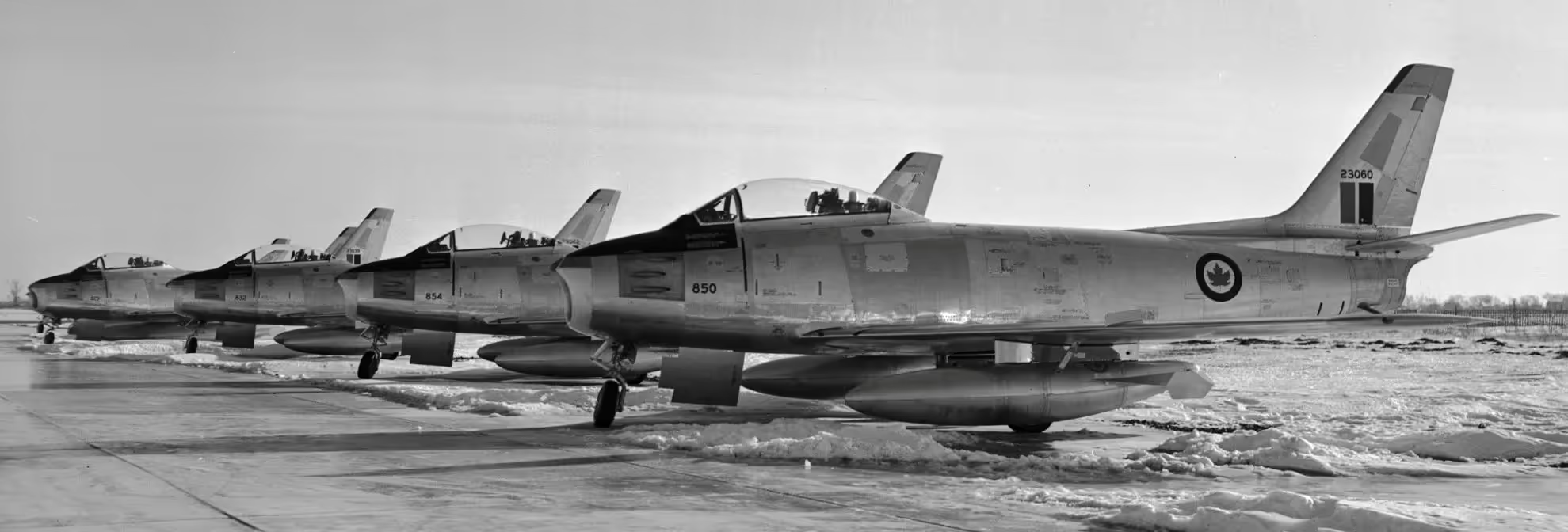
(DND Photo via James Craik)
Canadair F-86 Sabre Mk. 5, RCAF (Serial No. 23060), on the way to Europe with the OFU.

(RCAF Photo)
Canadair F-86 Sabre cockpit, ca 1953.

(Library and Archives Canada Photo, MIKAN No. 4948365)
Canadair F-86 Sabre Mk. 6 (Serial No. 23415) in formation over RCAF Station St Hubert, Quebec.

(DND Photo via James Craik)
Canadair F-86 Sabre Mk. 6 (Serial No. 23415) in formation over St Hubert, Quebec.
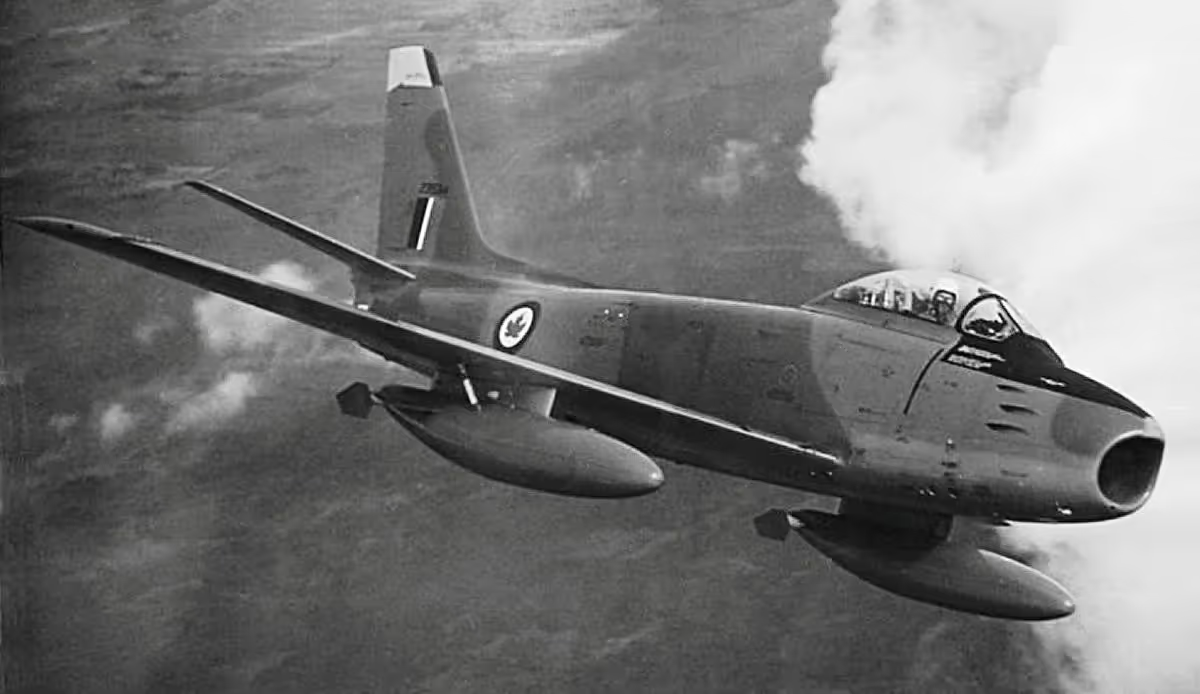
(DND Photo)
Canadair F-86 Sabre Mk. 6 (Serial No. 23534).

(DND Photo via James Craik)
Canadair F-86 Sabre Mk. 6 (Serial No. 23534).

(DND Photo via James Craik)
Canadair F-86 Sabre Mk. 6 (Serial No. 23439) plus two, factory fresh.

(DND Photo via James Craik)
Canadair F-86 Sabre Mk. 6 (Serial No. 23413), Bluie, Greenland, May 1955.
The Golden Hawks

(DND Photo via James Craik)
Canadair F-86 Sabres, Golden Hawk formation, 1959.
A separate page on this website is dedicated to the Golden Hawks.

(RCAF Photo)
Canadair F-86 Sabre Mk. 5, RCAF (Serial No. 23066), Golden Hawk.

(City of Vancouver Archives Photo, AM281-S8-: CVA 180-5465)
Canadair F-86 Sabre Mk. 5, RCAF (Serial No. 23066), Golden Hawk, Vancouver, 1969.
The Sky Lancers

(RCAF Photo via James Craik)
Pilots from all three Sabre squadrons at No. 2 (F) Wing flew with the aerobatic team, the Sky Lancers. The team was formed in March 1955 and performed throughout Europe until October 1955. The following year the team was based at No. 4 (F) Wing. In 1956, No. 4 (F) Wing at Baden-Soellingen, Germany provided the members of the Sky Lancers. On 2 March 1956, while practicing their routine over the Rhine valley, the Sky Lancers crashed near the Vosges mountains south west of Strasbourg killing four of the five team members. This accident put an end to RCAF aerobatic teams for several years.
A separate page on this website is dedicated to the Sky Lancers.

(Library and Archives Canada Photo, MIKAN No. 4948820)
Canadair F-86 Mk. 6 formation, RCAF Sky Lancers, 1955.
Pilots from all three Sabre squadrons at No. 2 (F) Wing flew with the aerobatic team, the Sky Lancers. The team was formed in March 1955 and performed throughout Europe until October 1955. The following year the team was based at No. 4 (F) Wing. In 1956, No. 4 (F) Wing at Baden-Soellingen, Germany provided the members of the Sky Lancers. On 2 March 1956, while practicing their routine over the Rhine valley, the Sky Lancers crashed near the Vosges mountains south west of Strasbourg killing four of the five team members. This accident put an end to RCAF aerobatic teams for several years.

(DND Photo via James Craik)
Canadair F-86 Sabre Mk. 5 (Serial No. 23180). Strapped in the cockpits of their Sabre aircraft Pilots of No. 413 Squadron are on two minute readiness awaiting the signal flares which will send them into the air to intercept 'enemy' raiders. No. 413 Squadron was on an exchange exercise with the Dutch Air Force, to test mobility and cross-servicing in the late 1960s.x
Canadair F-86 Sabre Survivors in Canada

(Author Photo)
Canadair F-86 Sabre Mk. 5 (Serial No. 23047), Oshawa Airport, Ontario. Mounted on a pylon.

(jiggs11 Photo)
Canadair F-86 Sabre Mk. 5 (Serial No. 23641), painted as (Serial No. 23053), Golden Hawks, mounted on a pylon in the Centennial Park, Zwick’s Island, Belleville, Ontario.


(Author Photos)
Canadair F-86 Sabre Mk. 5 (Serial No. 23060), coded PF. Mounted on a pylon at Sidney, British Columbia, Army Navy Club Grounds,

(RCAF Photo)
Sarnia, Ontario, Germain Park, Canadair F-86 Sabre Mk. 5 (Serial No. 23164), Golden Hawks. Mounted on a pylon.

(Author Photo)
Base Borden Military Museum, CFB Borden, Ontario, Canadair F-86 Sabre Mk. 5 (Serial No. 23228). Mounted on a pylon.

(monkeys4ever Photo)
Peterborough, Ontario, 428 Wing RCAFA, Canadair F-86 Sabre Mk. 5 (Serial No. 23245), No. 430 Squadron colours, formerly at Clinton, Ontario. Mounted on a pylon.

(Author Photo)
National Museum of the RCAF, CFB Trenton, Ontario, Canadair F-86 Sabre Mk. 5 (Serial No. 23257), previously painted in Golden Hawks colours, currently all silver. Outdoors.
Canadian Air Land Sea Museum, Markham, Ontario, Canadair F-86 Sabre Mk. 5 (Serial No. 23301), International Vintage Aircraft Inc., formerly at Picton, Ontario, silver. Outdoors.

(Alain Rioux)
Canadair F-86 Sabre Mk. 5 (Serial No. 23314), C-GSBR, Hawk 1, 20 Sep 2008. Official unveiling to the public of Hawk One belonging to Vintage Wings of Gatineau, Quebec. 23314 was flown to CFB Cold Lake, Alberta, where it was painted in the colours of a Golden Hawk. It took part in the Centennial of Flight celebrations in Canada in 2009, and appeared at airshows with the 431 squadron Snowbirds

(Aldo Bidini Photo)
Canadair F-86 Sabre Mk. 5 (Serial No. 23314), C-GSBR, Hawk 1,Vintage Wings of Canada, Gatineau, Québec. This aircraft was owned by Michael Potter. It has been sold.

(Author Photo)
Atlantic Canada Aviation Museum, Halifax, Nova Scotia, Canadair F-86 Sabre Mk. 5 (Serial No. 23355), Golden Hawks, formerly at CFB Chatham, New Brunswick. Indoors.

(Author Photo)
Canadair F-86 Sabre Mk. 5 (Serial No. 23457), painted as (Serial No. 23641), Golden Hawks, mounted on a pylon in the town of Trenton, Ontario.

Brockville, Ontario, Canadair F-86 Sabre Mk. 6 (Serial No. 23649), Golden Hawks. Mounted on a pylon.

(Author Photo)
Canadair F-86 Sabre Mk. 5 (Serial No. 23651), c/n 1441, Golden Hawks colours, Canadian Warplane Heritage Museum, Mount Hope, Ontario, on loan from the National Museum of Science and Technology since 25 July 1998. Indoors.
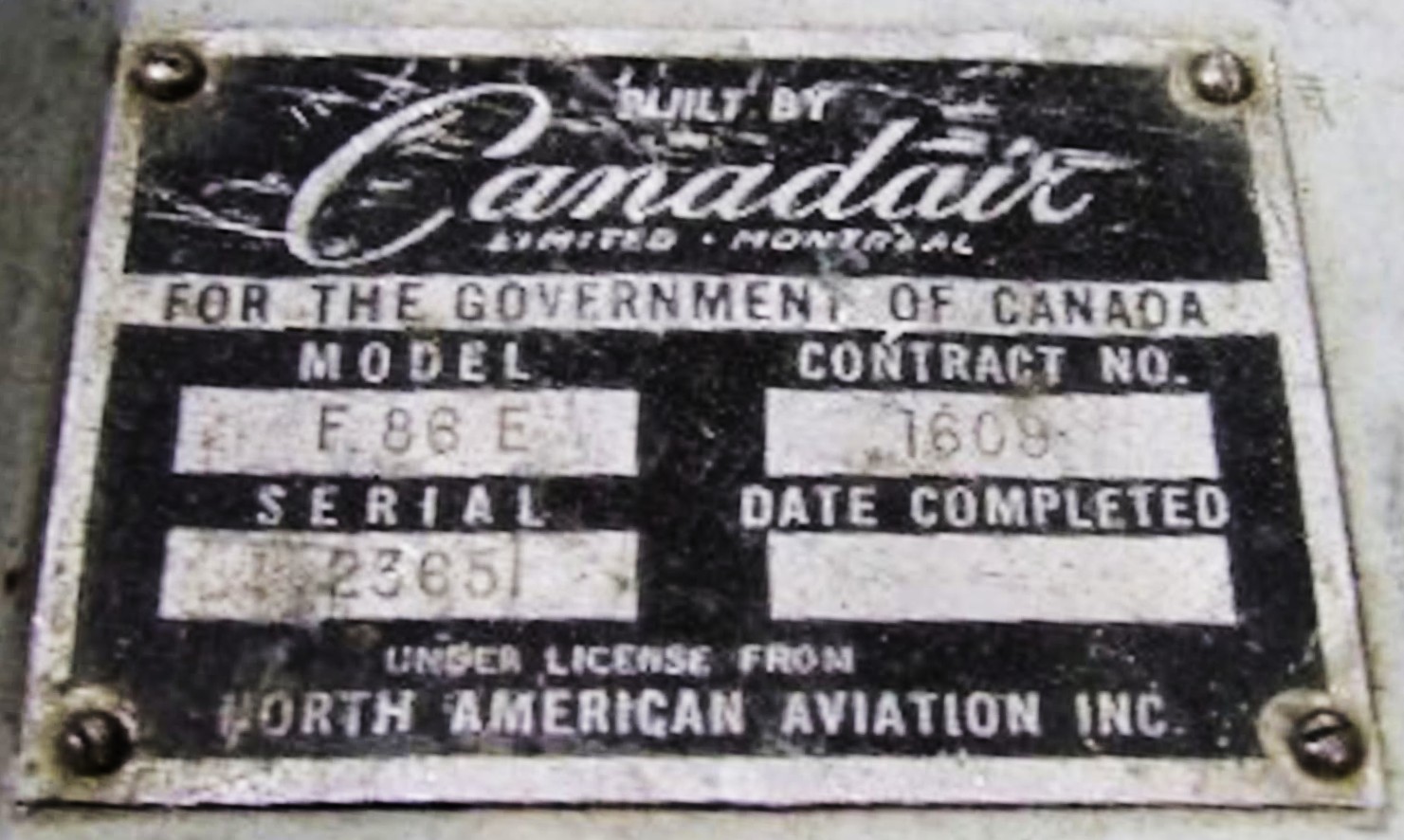
23651, one of the ultimate Canadair F-86B Sabre Mk 6 fighter series, was completed on 5 January 1956. Following the typical contractor’s ground, and flight tests over the next few months, this aircraft was flown and accepted by RCAF test pilot F/O A.H. Hoogen, then taken-on-strength in May 1956. It was sent overseas in June 1956, to serve with the NATO forces of No. 2 (F) Wing, and assigned to No. 421 “Red Indian” Squadron, coded AX-651, based at Grostenquin, France. Later, in 1960, following maintenance and refurbishment at Scottish Aviation Limited in Prestwick Scotland, Sabre 23651 was transferred to No. 1 (F) Wing, to serve with No. 439 “Sabre Tooth Tiger” Squadron, located at Marville, France, before finally returning to Canada at the end of December 1960. It was chosen for the 1961 season of the RCAF Golden Hawks aerobatics team, based at RCAF Station Chatham, New Brunswick. 23651 was flown by F/L Lloyd Hubbard in the ‘number 3’, position on the Left Wing of the formation. On 7 February 1964, the Golden Hawks were officially disbanded.

(Author Photo)
Canadair F-86 Sabre Mk. 6 (Serial No. 23651). Golden Hawks. This aircraft is currently on loan to the Canadian Warplane Heritage Museum, Mount Hope, Ontario.
23651, coded GH, was officially retired, with a total flying time of 1066.15 hours accumulated, and turned over to the No. 6 RD to prepare it for museum static display. Some of the original aircraft skins and panels on the port side of the fuselage were removed and replaced with clear Plexiglas panels in order to display the interior of the armament and engine bay areas. Painted in its 1963-1964 era Golden Hawks’ colours and markings, 23651, complete with its Orenda 14 engine (Serial No. 2066), was donated to the National Aviation Museum (NAM), newly located at the former RCAF Station Rockcliffe Aerodrome facilities, on 8 April 1964. (CASM)

(Author Photo)
Canadair F-86B Sabre Mk. 6 (Serial No. 23455), 1441, No. 444 "Cobra" Squadron, No. 4 (F) Wing, Baden-Soellingen, Germany.

(Robin Sipe Photo)
Canadair F-86 Sabre Mk. VI (Serial No. 23692), c/n 1482, Reg. No. N3844E. This Sabre was purchased from Courtesy Aircraft. It was last operated by the South African Air Force, and is currently in storage in Seattle, Washington, in very good, original, unrestored condition. The aircraft is to be moved to Fort St. John, BC where it will be restored to ground running, taxi capable condition in the short term, with long term plans for full restoration to flying status. The Aerospace & Technology Museum of British Columbia.

(Author Photo)
Canadair F-86 Sabre Mk. 5 (Serial No. 23292) wreckage of tail fin and main landing gear, preserved outdoors with the NBMHM, 5 CDSB Gagetown, New Brunswick.

Canadair F-86 Sabre Mk. 6 (Serial No. 23651), Golden Hawk, Canada stamp. (Library and Archives Canada Stamp, MIKAN No. 2266818)
Canadair F-86 Sabre data bank:
The North American F-86 Sabre was first flown on 1 October 1947 and the aircraft quickly proved to be a highly successful design. In 1949, with the formation of NATO the Canadian government made the decision to re-equip the RCAF’s front-line fighter squadrons with modern aircraft and the F-86 Sabre was type selected. Consequently, an agreement was reached between North American and Canadair Limited of Montréal to manufacture 100 F-86As in Canada. Canadair built the Sabre under licence in Canada, with the first one entering RCAF service in August 1950. The Mk. 1 was powered by a General Electric J-47-GE-13 engine. This aircraft is preserved in the AAM, Edmonton, Alberta, Canadair F-86 Sabre Mk. 1 (Serial No. 19101), PX-101.
The RCAF operated only one F-86A. F-86As were also used by RCAF personnel on exchange with the USAF in Korea. The single North American F-86A Sabre was powered by a General Electric J-47 - GE-13 engine. One is preserved in the ASMC, Calgary, Alberta, North American F-86A (Serial No. 47-606), unveiled June 1999, painted as (Serial No. 23175). This Sabre was previously on display in the Seattle Museum of Flight, Washington.

(Author Photo)
Canadair F-86 Sabre Mk. 5 (Serial No. 23363), Reg. No. N8686F, serving as an Experimental aircraft for the Boeing Company, visiting CFB Cold Lake, Alberta, 1978.
Canadair F-86 Sabre survivors:
Sidney, British Columbia, Canadair F-86 Sabre Mk. 5 (Serial No. 23060), Army Navy Club Grounds.
Belleville, Ontario, Canadair F-86 Sabre Mk. 5 (Serial No. 23641), painted as (Serial No. 23053), Golden Hawks, mounted on a pylon in the Centennial Park, Zwick’s Island.
CALSM, Markham, Ontario, Canadair F-86 Sabre Mk. 5 (Serial No. 23301), International Vintage Aircraft Inc., formerly at Picton, Ontario, silver.
BBMM, CFB Borden, Ontario, CanadairF-86 Sabre Mk. 5 (Serial No. 23228).
CWHM, Mount Hope, Ontario, Canadair F-86 Sabre Mk. 5 (Serial No. 23651), Golden Hawks colours, on loan from the National Museum of Science and Technology since 25 July 1998.
Oshawa, Ontario, Canadair F-86 Sabre Mk. 5 (Serial No. 23047), Oshawa Airport, Ontario.
Peterborough, Ontario, Canadair F-86 Sabre Mk. 5 (Serial No. 23245), formerly at Clinton, Ontario, 428 Wing RCAFA, mounted on a pylon.
Sarnia, Ontario, Canadair F-86 Sabre Mk. 5 (Serial No. 23164), Germain Park, Golden Hawks, mounted on a pylon.
NAFM, CFB Trenton, Ontario, Canadair F-86 Sabre Mk. 5 (Serial No. 23257), painted as (Serial No. 23641), Golden Hawks.
Vintage Wings of Canada, Hull Québec, Michael Potter, Canadair F-86 Sabre Mk. 5 (Serial No. 23314), C-GSBR, Hawk 1 project.
BGMM, CFB Gagetown, New Brunswick, Canadair F-86 Sabre Mk. 5 (Serial No. 23292) wreckage of tail fin and main landing gear.
ACAM, Halifax, Nova Scotia, Canadair F-86 Sabre Mk. 5 (Serial No. 23355), Golden Hawks, formerly at CFB Chatham, New Brunswick.

(Author Photo)
BADM, CFB Bagotville, Québec, Canadair F-86 Sabre Mk. 6 painted as (Serial No. 23444), in No. 444 Squadron colours, on display at the main gate to the airfield at CFB Lahr, Germany, ca 1992. It previously served with the German Air Force (Serial No. JC-373), at Nauhausen, Germany. This Sabre came to CFB Bagotville, Quebec, in 1994. It is now in a silver scheme and is painted as (Serial No. 19454), coded AO, No. 414 Squadron, mounted on a pylon.

(Author Photo)
AFHM&AP, CFB Winnipeg, Manitoba, Canadair F-86 Sabre Mk. 6 (Serial No. 23605), No. 439 Squadron colours, camouflaged. It is shown here when it was previously on display at CFB Baden-Soellingen, Germany. It was an ex-German Air Force Sabre, C/N 1605, based at Koln, Germany. It was returned to Canada in July 1981.
ACAM, Winnipeg, Manitoba, Canadair F-86 Sabre Mk. 6 (Serial No. 23760), C/N 1815, Western Canada Aviation & Space Museum, formerly served with the Pakistan Air Force, Masroor AB, Pakistan, served as a decoy, silver.
Brockville, Ontario, Canadair F-86 Sabre Mk. 6 (Serial No. 23649).
CA&SM, Ottawa, Ontario, Canadair F-86 Sabre Mk. 6 (Serial No. 23455).
Kingston, Ontario, Canadair F-86 Sabre Mk. 6 (Serial No. 23221), formerly at Royal Roads Military College (RRMC), now at the Royal Military College (RMC), mounted on a pylon.
Canadair F-86 Sabre survivors outside of Canada:
Canadair F-86 Sabre Mk. 6 (Serial No. 23042), Golden Hawks, displayed in the Auto-Technical Museum (ATM), Speyer, Germany, ex German Air Force BB+283 (Serial No. 1613).
Canadair F-86 Sabre Mk. unknown, (Serial No. unknown), German Air Force Markings, Deutsches Museum, München, Germany.
Canadair F-86 Sabre Mk. 6, German Air Force (Serial No. unknown), coded JC+101, Hermeskeil, Germany.
Canadair F-86 Sabre, Mk. 5, German Air Force (Serial No. 840), JB-111, coded BB+239, International Luftfahrt Museum, Schwenningen, Germany.
Canadair F-86 Sabre Mk. 6, JB+110, German Air Force Markings, Militarhistorisches Museum, Dresden, Germany.
Canadair F-86 Sabre Mk. 6, (Serial No. unknown), coded BB+150, ex BB-250 (Serial No. 895), (01-01).

(Clemens Vasters Photo)
Canadair F-86 Sabre Mk. 6 (Serial No. 1591), German Air Force, D-9542, Luftwaffe Museum, Berlin-Gatow, Germany.
Canadair F-86 Sabre Mk. 6 (Serial No. 1603), German Air Force Markings, Luftwaffe Museum, Berlin-Gatow, Germany.
Canadair F-86 Sabre Mk. unknown (Serial No. unknown), Uetersen, Germany.
Canadair F-86 Sabre Mk. 6, JA-112, Serial unknown, German Air Force Markings, Wittmund German AFB.
Canadair F-86 Sabre Mk. 6 (Serial No. 23363), Haydon-Baillie Aircraft and Naval Collection, UK.
Canadair F-86 Sabre Mk. 6, Museum of Flight, Seattle Washington, USA.
Canadair F-86 Sabre Mk. 6, Blaine Golden Age Aircraft Museum, Minnesota, USA.
Canadair F-86 Sabre Mk. 6, Medford Air Victory Museum, New Jersey, USA.
Canadair F-86 Sabre Mk. 6, Nellis AFB, Nevada, USA, Reg No. N86EX, ex SAAF (Serial No. 380).
Canadair F-86 Sabre Mk. 5, Reg. No. N86FS, Mojave, California, Flight Systems, Mojave, California, USA.
Canadair F-86 Sabre Mk. 5, Reg. No. N91FS, formerly operated by Flight Systems Incorporated at the Mojave Airport, Global Aerospace of Newport Beach, California, USA.
Canadair F-86 Sabre Mk. 6, Reg. No. N38453, restored as USAF F-86F (Serial No. 51-13487), flown by Al Hansen, it flew for the South African Air Force as (Serial No. 378). It was registered by Flight Systems in October 1983 and then to Global Aerospace in September 1992.
Canadair F-86 Sabre, Reg. No. N106JB, SAAF colours, War Eagles Museum, Santa Teresa, New Mexico, USA.
Canadair F-86 Sabre Mk. unknown, (Serial No. unknown), Kempten Park Technical College, RSA, South Africa.
Canadair F-86 Sabre, Mk. and unknown, (Serial No. unknown), Snake Valley, South Africa.
Canadair F-86 Sabre, Mk. and unknown, (Serial No. unknown), Swartop, SAAF Museum, South Africa.
Canadair F-86 Sabre, Mk. unknown (Serial No. unknown), coded 13-1, Italian Air Force Museum, Vigna di Valle, Rome, Italy,
Canadair F-86 Sabre, Mk. unknown, (Serial unknown), Museo Storico, Italy.
Canadair F-86 Sabre Mk. 6, C/N 1792, (Serial No. unknown), Pakistan Air Force Museum, PAF Faisal, Karachi, Pakistan.
[1] Internet: http://en.wikipedia.org/wiki/Canadair_Sabre.
[2] Internet: Http://www.rcaf.com/aircraft/fighters/sabre/index.php?name=Canadair%20Sabre.
[3] Internet: Http://www.rcaf.com/aircraft/fighters/sabre/index.php?name=Canadair%20Sabre.

(DND Archives Photo, PL-5576)
Canadair F-86 Sabre test fires its six .50 cal machine guns.
Canadian Sabre pilots in the Korean War, 1950-1953
Twenty-one Royal Canadian Air Force (RCAF) fighter pilots (in addition to Flight Lieutenant Omer Lévesque, who was already serving on exchange with the Americans when the war broke out) volunteered to fly F-86 Sabres with the United States Air Force (USAF), although not all of them saw combat.
They flew with the USAF’s 4th Fighter Interceptor Wing (FIW) at Kimpo or 51st 51st Fighter Interceptor Wing (FIW) at Suwon and served for six months or 50 combat missions, whichever came first. A combat mission usually consisted of flying 200 miles (320 kilometres) over enemy territory to the infamous “MiG Alley” (near the Chinese border) area, patrolling, contacting and fighting with the communists’ MiG-15s. The RCAF accounted for nine MiG “kills”, two “probables” and 10 “damaged”.

(RCAF Photo)
F/L Ernie Glover shot down three MiG-15s.
High scoring pilots included Flight Lieutenant (F/L) Ernie Glover with three kills and three damaged, and Squadron Leader (S/L) Doug Lindsay with two kills and three damaged. Most RCAF personnel who served in the Korea theatre, approximately 800, belonged to 426 Squadron while the remainder were fighter pilots, flight nurses, and supply, technical and photo intelligence personnel. As well, a number of Canadian Army personnel flew with the USAF as forward air controllers in the 6147 Tactical Air Control Group, informally known as the “Mosquitos”.

(Library and Archives Canada Photo, MIKAN No. 4816361)
On 13 May 1954, F/L Earnest A. Glover was presented with the American Distinguished Flying Cross (DFC) for his "extraordinary achievements" while flying USAF Canadair built F-86E-6 Sabres in combat in Korea. At the station parade at No. 4 Fighter Wing, RCAF Station Baden-Soellingen, Germany, General Robert Merrill Lee, Commanding General, 4th Allied Tactical Air Force, Trier, Germany, pinned the award on F/L Glover.

(Canadair Photo via Mario Pompetti)
Canadair F-86 Sabre, test flight out of Montreal, 1958.





